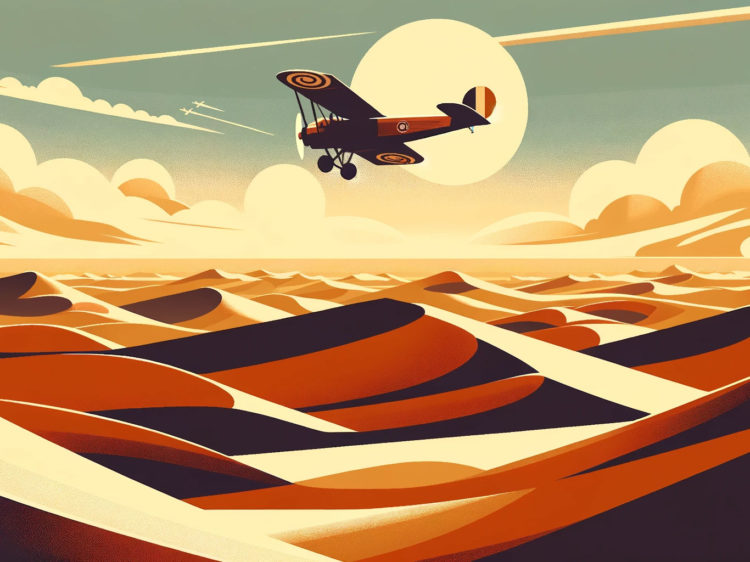Summary of “Wind, Sand and Stars”, one of Antoine de Saint-Exupéry’s most celebrated works. Published in 1939, this memoir combines adventurous narratives from his days as an airmail pilot with philosophical musings about the nature of humanity, responsibility, and life itself. The book won the Grand Prix du roman de l’Académie française and remains a staple of aviation literature, beloved for its profound insight into the human spirit and the beauty and dangers of the early days of flight.
Comprehensive Summary of “Wind, Sand and Stars”
Each part of “Wind, Sand and Stars” combines gripping tales of aviation with deep philosophical musings, making it a timeless work that continues to inspire and captivate readers.
Part I: The Craft
Saint-Exupéry opens with a reflection on the nature of flying and the camaraderie among pilots. He describes the demanding life of airmail pilots, the perils they face, and the intimate relationship they have with their aircraft, which they know as deeply as a sailor knows his ship.
Part II: The Men
The author introduces his colleagues, men who are not daunted by danger. He narrates their stories, including that of Mermoz and Guillaumet, whose resilience and bravery become a recurring theme. He paints a vivid picture of their characters and the challenges they face.
Part III: The Tool
Saint-Exupéry discusses the evolution of aircraft technology and its impact on aviation. He offers a critical view on the relationship between humans and machines, stressing that despite technological advancements, the human element remains indispensable.
Part IV: The Elements
Here, the author describes the experience of flying over the Andes, the elements they encounter, and the sheer force of nature. He reflects on the insignificance of man against the backdrop of the universe, and yet, how man’s spirit perseveres.
Part V: The Combat
The memoir recounts Saint-Exupéry’s experience of a crash in the Sahara Desert. He and his navigator Prévot struggle against the relentless desert, fighting thirst and despair. It’s a testament to the human will to live and the unexpected mercies that can come in the darkest moments.
Part VI: The Survivors
Survival in the desert leads to a bond between Saint-Exupéry and Prévot. He contemplates the idea of being reduced to basic existence, where the value of life is distilled to its essence. He also recounts the story of his friend Guillaumet, who survived a crash in the Andes.
Part VII: The Encounter
Saint-Exupéry meets a slave trader and grapples with the moral implications of his indifferent attitude towards human life. This encounter forces a reflection on the meaning of civilization and the role each individual plays within it.
Part VIII: The Ascent
He describes a treacherous mission over Spain during the Spanish Civil War. The experience serves as a backdrop for a meditation on the nature of war and the loss of life, contrasting it with his earlier experiences of unity and shared humanity.
Part IX: The Immortals
The final part is a philosophical inquiry into the nature of existence, immortality, and what remains after death. Saint-Exupéry concludes that the connections between people and the actions that define their lives are the true markers of immortality.
Interesting Facts
- Authentic Adventures: The book is based on Saint-Exupéry’s real-life experiences as a mail pilot and director of the Aeroposta Argentina airline.
- Prestigious Award: It won the Grand Prix du roman de l’Académie française, a major French literary award, in 1939.
- Human Connections: Saint-Exupéry emphasizes the profound human connections formed during times of adversity, a central theme in his works.
- Survival Story: The author’s account of surviving a desert crash is both harrowing and existential, revealing his philosophical depth.
- Technological Reflections: The novel explores the relationship between man and machine, pondering the advancements in aviation technology.
- War Commentary: Saint-Exupéry offers insights into the Spanish Civil War, drawing from his own experiences as a journalist and pilot.
- Philosophical Depth: The work delves into themes of existentialism, the meaning of life, and what defines humanity.
- Literary Style: Saint-Exupéry’s poetic prose and rich metaphors elevate the book from a mere adventure narrative to literary art.
- Influence on “The Little Prince”: Some aspects of “Wind, Sand and Stars” prefigure themes and scenes in his later work, “The Little Prince”.
- Legacy: The book’s enduring popularity has solidified Saint-Exupéry’s reputation as not only an adventurer but also a major literary figure.
Frequently Asked Questions About “Wind, Sand and Stars”
How did “Wind, Sand and Stars” influence “The Little Prince”?
Themes of human connection, responsibility, and the essence of life explored in “Wind, Sand and Stars” reappear in a more allegorical form in “The Little Prince“.
What inspired Saint-Exupéry to write “Wind, Sand and Stars”?
Saint-Exupéry drew inspiration from his experiences as an airmail pilot. His flights over the Sahara, the Andes, and other remote areas provided the real-life adventure that underpins the narrative.
How does “Wind, Sand and Stars” reflect on the theme of human connection?
The book reflects deeply on human connections, particularly how shared experiences, especially challenging ones, can create unbreakable bonds between people.
Is “Wind, Sand and Stars” a work of fiction?
While the work contains philosophical reflections and poetic language, it is not fiction. It’s a memoir that recounts Saint-Exupéry’s real-life experiences as a pilot.
What philosophical views does Saint-Exupéry express in “Wind, Sand and Stars”?
Saint-Exupéry delves into existentialism, touching on themes like the meaning of life, solitude, friendship, death, and the human condition.
How does the book approach the subject of technology, especially in aviation?
Saint-Exupéry often muses on the advancements in aviation technology, contemplating the relationship between humans and machines and how they change our interaction with the world.
Can “Wind, Sand and Stars” be considered an adventure story?
Yes, it can. The book recounts thrilling tales of aviation adventures, near-death experiences, and the pilot’s intimate relationship with his plane and the vast landscapes he traverses.
🌵✈️ Is Saint-Exupéry an aviator-philosopher or just spinning tales in the clouds? Share your verdict below! ☁️👇


Comments